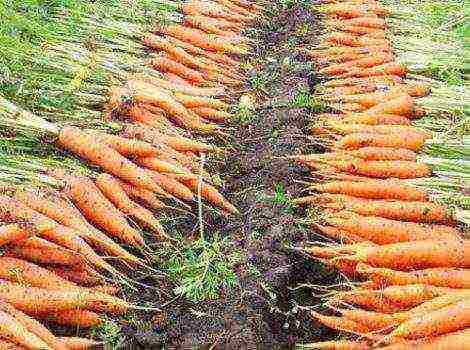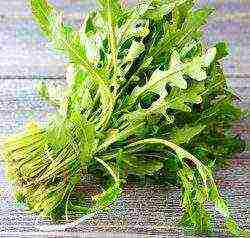Content
White cabbage is an incredibly healthy vegetable with a rich vitamin and mineral composition. This explains its popularity among gardeners. The cultivation rules are not complicated, but the basis for the yield depends on the choice of the variety.
Varietal variety of white cabbage
In the old days, there was really a shortage of seed material due to limited supplies from the near and far abroad, therefore, the seeds were often harvested from the usual varieties.
For more than 20 years, the situation has radically changed, and the varietal assortment of many gardeners continues to consist of 2-3 positions. And in vain, because new developments have no less valuable qualities, which consist in resistance of cabbage to diseases and pests.
This is especially important when you consider that the moisture-loving plant literally attracts insects and fungi.
This article discusses early, mid-season and late-ripening varieties of a popular vegetable with a description that will expand the variety of crops grown in your garden and in the Urals and in the middle lane.
Most Popular
The variety of cabbage is selected not only taking into account the winter and climatic characteristics of the region, but also by appointment... The mineral and vitamin composition of each plant is different, but it is also influenced by the conditions of agricultural technology and the type of soil.
In order to choose the appropriate option it was easier, the varietal assortment is divided into groups, united by a common feature.
The best late varieties of cabbage for long-term storage
Aggressor Is a mid-late hybrid developed by breeders from Holland. Differs in minimal care and resistance to fusarium, thrips damage.
Vegetation lasts up to 120 days, you can sow seeds directly on an open bed. A ripe vegetable weighs 3-5 kg. Shelf life and processing - up to 5 months.
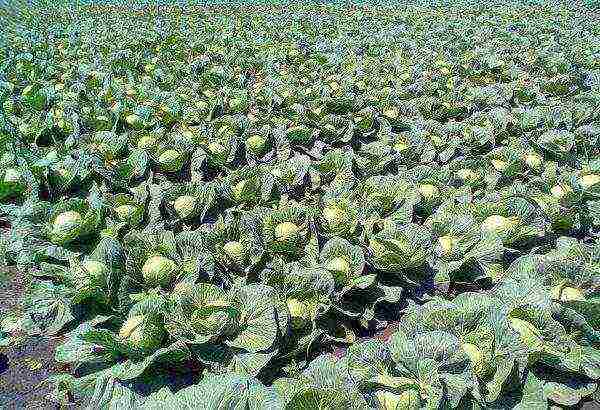 Aggressor
Aggressor
Amager - late cabbage with a ripening period 120-147 days... The heads are round-flat green, sometimes with a bluish tinge, weight about 3-4 kg.
When planting, the scheme is used: 3-4 plants per 1 m2. For six months, the nutritional value and presentation are preserved. Weather cataclysms and violation of the watering regime do not violate the density of the structure and the integrity of the head.
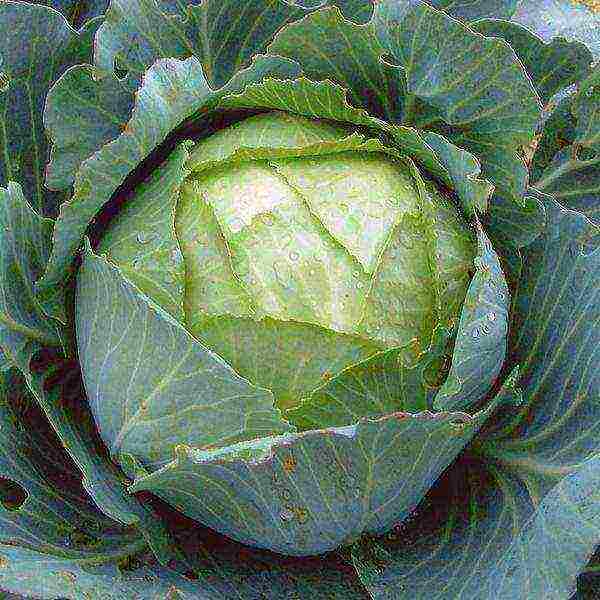 Amager
Amager
Valentine - growing season 155-180 days after transferring seedlings to open beds. The gray-green heads have a slight waxy coating, the weight tightens up to 4 kg.
Cabbage retains its taste and presentation until the beginning of the next season (June). The hybrid is tolerant to fusarium, gray rot. The head of cabbage does not crack due to violations of the moisture regime.
When planting, the scheme is used: 2-4 plants per 1 m2.
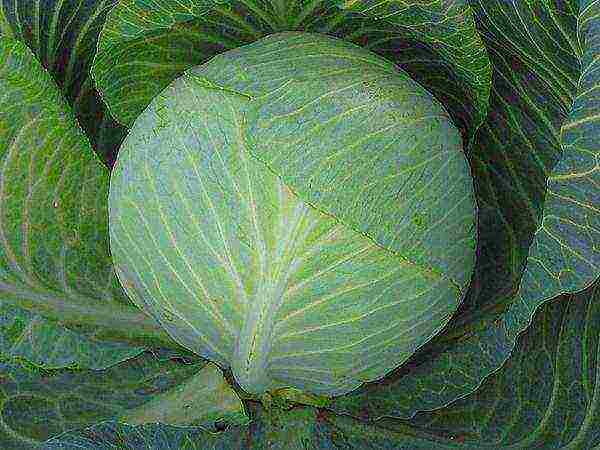 Valentine
Valentine
Gingerbread man - hybrid forms heads later 115-125 days after planting seedlings. Round fruits have a dense structure, the average weight is 2-3 kg. Planting scheme: 3-4 plants per 1 m2.
Due to its good immunity, it exhibits tolerance to punctate necrosis and thrips. For 8-10 months, cabbage retains its nutritional value and presentation.
 Gingerbread man
Gingerbread man
Mara - very dense heads are not susceptible to cracking, the average weight is 3 kg. The variety is distinguished by good taste, transportability and long shelf life (more than 7 months).
The main advantage is resistance to the accumulation of nitrates and radionuclides. Vegetables are harvested through 160-175 days after transplanting seedlings.
 Mara
Mara
Moscow - a variety developed by domestic breeders, who took into account the climatic features and possible problems with pests when growing.
Harvesting begins later 130-140 days after disembarking seedlings. Gray-green rounded heads of cabbage weigh 4-7 kg on average. When planting, the scheme is used: 2-3 plants per 1 m2.
Cabbage is resistant to cracking, has a delicate juicy pulp. Without loss of taste and presentation, the vegetable is stored for 6-8 months.
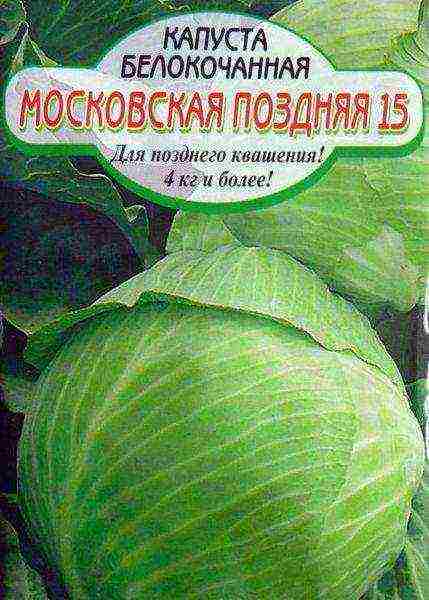 Moscow
Moscow
Mid-season white cabbage
Megaton - the hybrid matures in 102 days after planting seedlings. The great need for moisture and fertilizers strengthens the immune system, which resists many diseases and insect infestations.
The round-flattened gray-green head weighs up to 15 kg. The location of the holes when planting: 3 plants per 1 m2. Duration of storage without loss of nutritional qualities and presentable appearance is 4-6 months.
Merchant's wife - a disease-resistant high-yielding variety, distinguished by simple agricultural technology. About 500 centners are removed from a hectare (head weight up to 3 kg). When planting, the scheme is used: 3-4 plants per 1 m2.
Harvesting begins later 130-150 days after transferring seedlings to the beds.
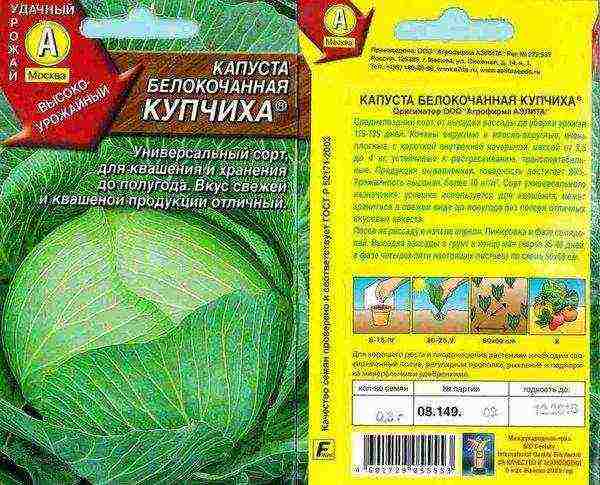 Merchant's wife
Merchant's wife
Atria - the fruit of the works of Dutch breeders with the growing season 110-120 days... The head of cabbage has a round-flat head of blue-green color, the average weight of which reaches 5-7 kg. Often there are specimens of 8-8.5 kg. When planting, the scheme is used: 3 plants per 1 m2.
Thanks to its good immunity, it resists pests (in particular thrips) and fusarium. The commercial and taste qualities are preserved for 4-6 months.
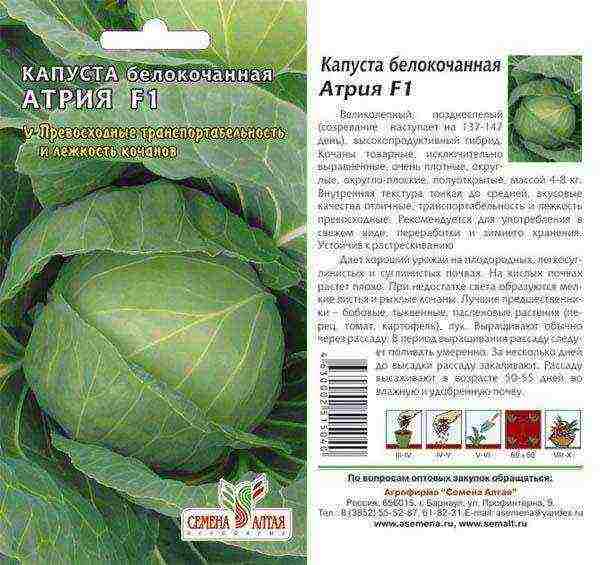 Atria
Atria
Glory - the fruit of the work of Russian breeders, the growing season is 120-130 day after planting seedlings.
Round heads have a light green color with a grayish tinge, the weight tightens up to 3-5 kg. When planting, the holes are arranged according to the scheme: 3-4 plants per 1 m2.
The advantage of the variety is its taste, the disadvantage is short storage (about 2 months). Glory is one of the best pickling options.
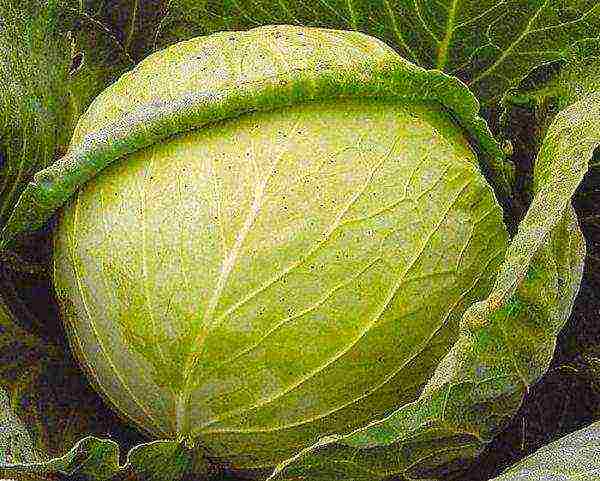 Glory
Glory
Sugar queen - the hybrid ripens after planting seedlings through 120-140 days... Dense rounded heads have a slightly greenish tint, weighing up to 4 kg.
When planting, the scheme is used: 3 plants per 1 m2. A universal variety, used fresh and for salting. The shelf life without loss of valuable qualities is 3-4 months.
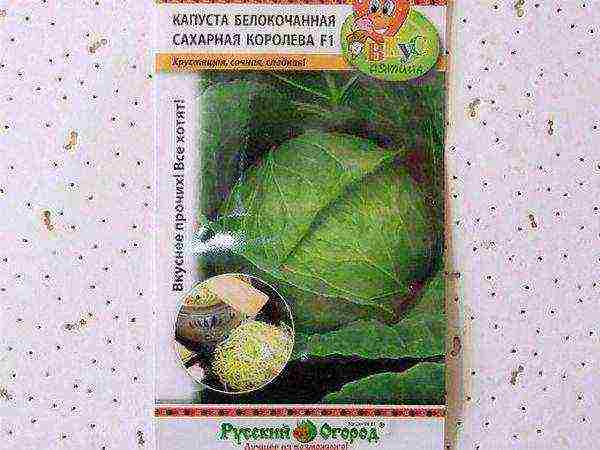 Sugar queen
Sugar queen
Early ripe
Rinda - the ripening period of the hybrid is 75-80 days after disembarking seedlings. Round heads weighing up to 7 kg have a green color and a dense structure. Hole layout: plant 3-5 plants per 1 m2. Differs in unpretentiousness to weather conditions.
The shelf life without loss of taste and presentation does not exceed 4 months.
 Rinda
Rinda
Kazachok - an early hybrid is distinguished by early maturity, you can harvest through 45-55 days after disembarking seedlings. The weight of the medium-sized light green head is 1.5 kg.
The scheme used for planting: 5-6 plants per 1 m2. Recommended for cultivation under any kind of film and in the open field. Cabbage resists the causative agents of mucous bacteriosis and black leg.
 Kazachok
Kazachok
June - the variety is ready for planting in open ground already at the beginning of May, after 45-50 days you can harvest. The structure of the head is of medium density, the weight reaches 1.4-1.7 kg. When grown on highly fertile soils, the weight of the head of cabbage reaches 5 kg.
The layout of the holes when planting: 3-5 plants per 1 m2. Cabbage is distinguished by the amicability of the emergence of seedlings and excellent taste.
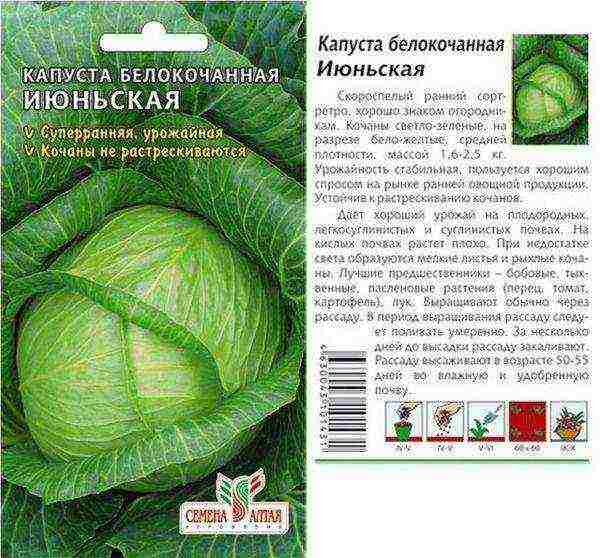 June
June
Tobia Is a Dutch hybrid characterized by resistance to fusarium wilt. The layout of the holes when planting: 2-3 plants per 1 m2. Dark green round-flat heads weigh up to 7 kg. Fruit ripening occurs later 85-90 days after disembarking seedlings.
It has a strong root system, if the irrigation regime is violated, the head of cabbage does not crack. It retains its taste and marketability for 5-6 months.
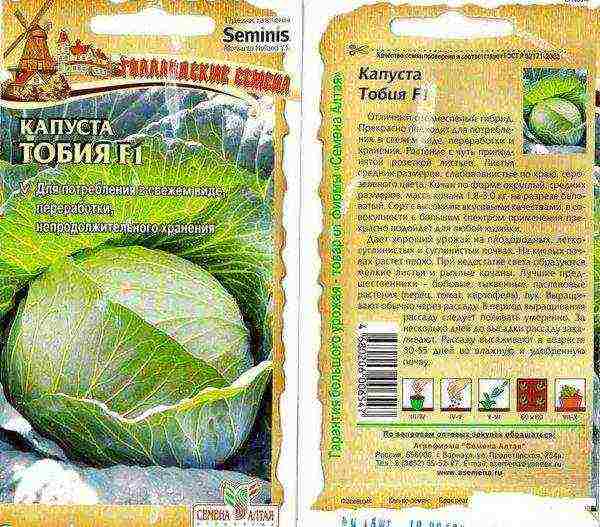 Tobia
Tobia
Varietal variety will ensure productivity even in difficult weather conditions, because each plant has its own immunity to diseases and pests. The taste qualities of the varieties stimulate new experiments, which continue already in the kitchen.
.
White cabbage is one of the most popular culinary products. It is used for the preparation of various types of dishes, for sourdough and fresh consumption. To grow cabbage pleasant and not painful, you need to understand the types of varieties. Cabbage is early-ripening, mid-ripening and late ripening.
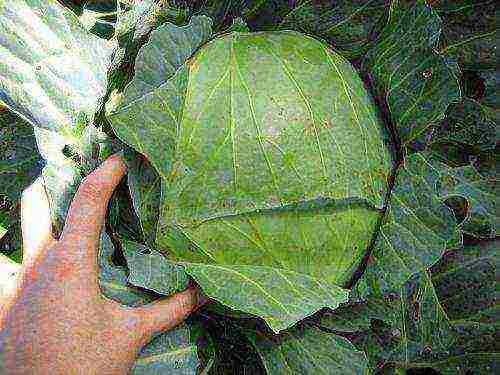
Cabbage Gift - a popular mid-season variety
Description of the varieties Gift and Menza
The best and most popular varieties of white cabbage are a gift and menza. The cultivation of varieties is not very difficult, since these species are the best because, together with good taste, they are resistant to diseases and high yields.
The main signs of the leadership of these varieties are the high weight of the head of cabbage and multifunctional use. If there are varieties of cabbage that are not suitable for fermentation, then the gift and menza can be used in different types, and eaten fresh, fermented, etc.
Optimal is the cultivation of cabbage with medium ripening times. The mid-season product comes in different varieties: Gift, Menza.
The shape of the head of cabbage The gift takes on a rounded shape, sometimes squeezed. The leaves take on a greenish tint, and are arranged in medium density. The leaves are even and have a natural sheen. The weight of one head of cabbage reaches five kilograms. The palatability of the varieties is positive. Endowed with a natural high yield. With the correct planting density, up to fifteen kilograms of cabbage can be harvested from one square meter.
The maturity of the harvest occurs on the one hundred and twentieth day. The gift can be planted and grown in Siberia and the Urals. Subject to transportation and long-term storage, heads of cabbage can be stored under appropriate conditions for four months.
The positive features of the Podarok variety are its long storage time, appearance and taste of the harvest.
The Menza variety is a hybrid of white cabbage. The weight of one head of cabbage reaches nine kilograms. To achieve such results, you need to provide the variety with proper feeding and planting material care. The shape of the product is round and compressed, it has a small stump. Correct planting of cabbage allows you to increase the weight of one head of cabbage and the entire crop as a whole.
Cabbage matures on the one hundred and tenth day after transplanting. Suitable for growing in different climatic regions. This variety is often exposed to various pests and diseases.
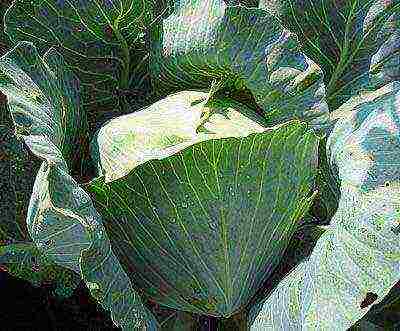
Cabbage Menza - hybrid variety weighing up to 9 kg
Characteristics of mid-season varieties
There are many varieties of cabbage that are endowed with medium ripening times. White cabbage is grown from seeds or seedlings. Whichever method you choose, you can use seeds or seedlings of the following cabbage varieties:
- Glory.
- Atria.
- Dobrovodskaya.
- Midor.
- Krautman.
- Megaton.
- The merchant's wife.
Glory is endowed with popularity. The maturity of the seeds of glory begins on the one hundred and fifteenth days after transplanting into open ground. The product is consumed fresh and sent for processing. The shape of the head of cabbage is squeezed and rounded. The weight of each white cabbage reaches five kilograms. The leaves have a greenish tint, they are white inside. The cultivation of seeds of the Slava variety is suitable for a temperate climate with a high degree of humidity. Subject to long-term storage and transportation. His disease tolerance is average.
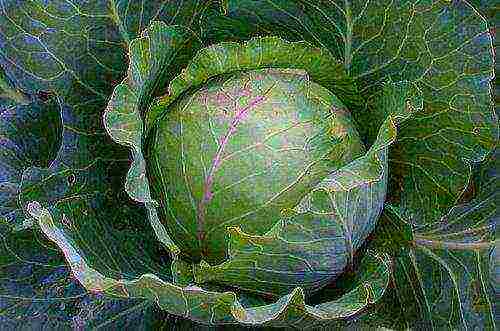
Slava cabbage has good transportability
Atria seeds ripen one hundred and thirty days after transplanting into open ground and give a head of cabbage with dark green leaves.The weight of one head of cabbage reaches four kilograms under the conditions of proper seed and seedling care. The seeds of the variety are resistant to diseases, do not crack and give high yields.
Dobrovodskaya white-headed variety is used mainly for sourdough, as its taste is excellent for such use. The color of the juicy white cabbage is white. The seeds of the variety have natural resistance to disease. It can be stored for six months after the white cabbage crop has already been harvested.
Midor ripens one hundred and fortieth days after planting. The seeds produce a product with rich green leaves. The crop has a natural pleasant taste that allows it to be used for different purposes.
The seeds of Krautman cabbage, when ripe, produce heads of cabbage with thick and tasty leaves. The stump inside the head of cabbage is small. The variety can gain weight up to five kilograms. The crop will not crack or rot, even in the accompanying climatic conditions. The characteristics of the variety allow it to be stored for four months after harvest. It is resistant to disease.
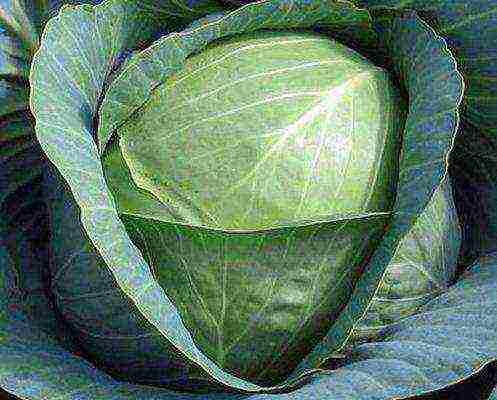
Krautman Cabbage - Disease Resistant and Stable
Megaton product belongs to hybrid varieties of white cabbage. The mid-ripening variety ripens on the hundredth day after the seeds have been transplanted into open ground. The weight of round heads of cabbage reaches fifteen kilograms and has a natural excellent taste. Cabbage seeds are obtained thanks to the selection of Dutch scientists. The head of cabbage is even and does not crack in conditions of high humidity. It can be eaten fresh and processed. The crop can be transported and stored for a long time. The variety is disease resistant.
The Merchant's cabbage has a green outer and white inner layers. The weight of one head of cabbage is small and reaches a maximum of three kilograms. The taste characteristics of the variety are positive, it is resistant to diseases and is subject to long-term transportation.
Mid-season cabbage is a common product that is used for consumption both fresh and processed.
Subscribe Be aware of new products on our site
How to grow cabbage
The cultivation of mid-and late-ripening white cabbage has its own characteristics.
First, the soil is cultivated in spring when it reaches normal ripeness in your garden plot and you can dig (plow) to the full depth of the shovel. Secondly, you can start making ridges and ridges on excessively moist soils.
Usually, the width of the surface of the ridges when growing white cabbage should be in the range of 100-120 cm, the height is 18-25 cm or more, depending on the degree of soil moisture. When making ridges, the soil should not be strongly compacted along the sides, so that there is no excessive loss of moisture for evaporation.
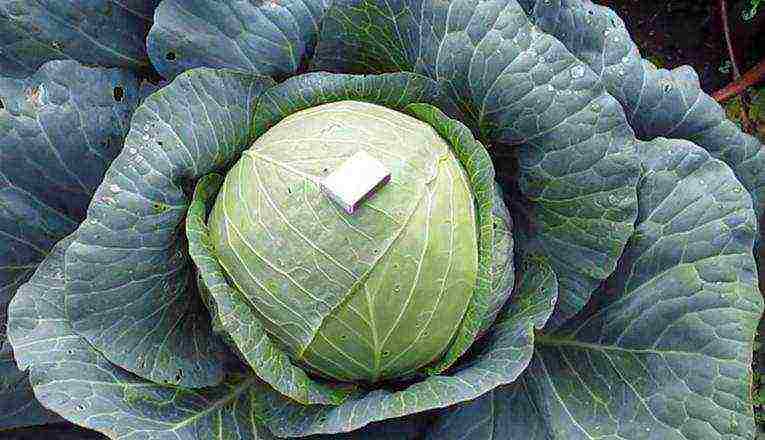
Photo of mid-season cabbage varieties Megaton
They fill the soil with organic fertilizers, if they were not applied in the fall or during the spring digging. It is advisable at this time to apply mineral fertilizers: ammonium nitrate or urea, superphosphate, potassium salt. It is better to apply organic fertilizers when planting seedlings in a hole (500 grams of humus each).
After digging, the soil is leveled with a rake and rows are marked. For growing cabbage of a medium or late ripening variety, row spacings of 60-70 cm are made. The distance in a row for medium varieties is 40-50 cm, for late white cabbage - 50-70 cm.
Planting technique is the same as for early maturing cabbage.
After planting, the soil must be regularly loosened, the plants must be hilled two or three times, watered, fed, weeded, and pests and diseases must be fought.
The first loosening of the row spacings is carried out on the day of planting mid-season or late white cabbage, the subsequent ones - as needed, but preferably after each rain or watering. The depth of loosening should increase as the plants grow: the first loosening - by 5-8 cm, then up to 12 cm.
The first hilling of the cultivated white cabbage is carried out approximately 20-25 days after planting.On waterlogged soils, it is necessary to huddle in two directions.
Hilling is especially effective both in combating weeds in rows and for the formation of additional roots on the stump (stem). When hilling, loose soil is poured under the rosette of leaves, which suppresses the growth of weeds and promotes the awakening of the roots, which increase the nutrition and supply of plants with moisture. Before. the closing of leaves in rows is carried out up to 2-3 hilling.
It is necessary to constantly monitor the state of soil moisture.
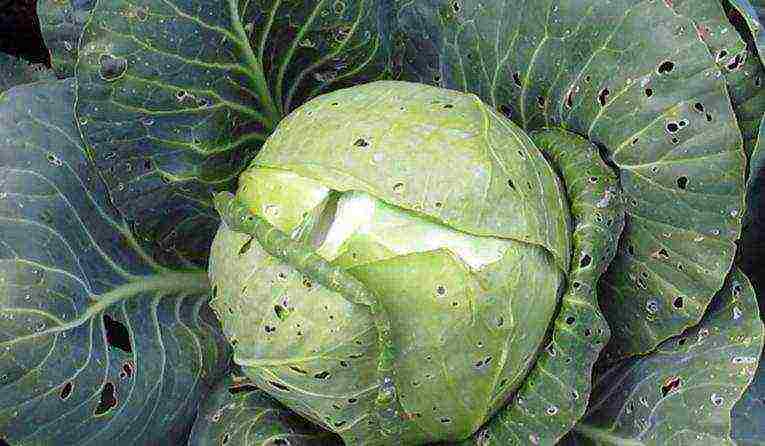
In the photo there is a mid-ripening cabbage variety Rinda
Leaves should not be allowed to wither due to lack of moisture. Watering time is determined as follows. They take a handful of earth in the upper soil layer at a depth of 20-25 cm, squeeze it tightly in the palm of your hand and throw a lump on a dense path from a height of 90-100 cm.
Another way: if the soil taken from a depth of 20 cm does not roll into a ball or forms into a fragile ball that disintegrates when pressed, then watering is required.
Usually, in the central regions, late white cabbage (as well as mid-season) cabbage is watered 3-4 times, in the north-western regions - 1-4 times, depending on growing conditions.
After each watering, the soil must be loosened to destroy the soil crust and preserve moisture.
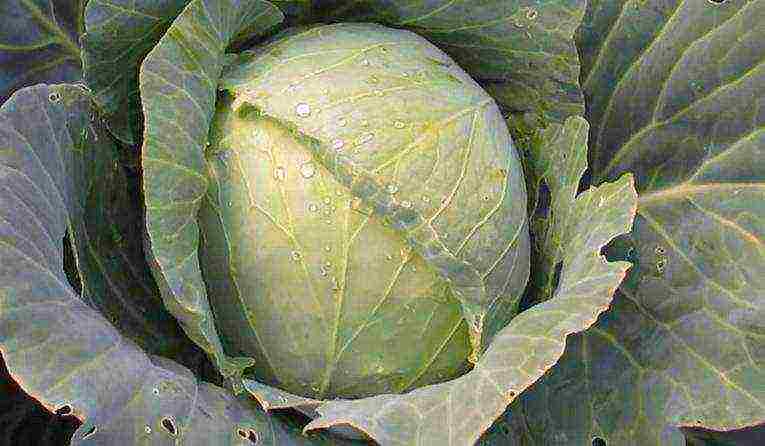
In the photo there is a mid-ripening white cabbage variety Hope
Mid-ripening and late-ripening cabbage varieties are distinguished by an increased requirement for nitrogen and potassium during their cultivation.
The first feeding is carried out during the period of increased leaf growth and the beginning of the formation of the rosette. Introduce 15-25 g / m² of active substance nitrogen, 15-20 g / m² of phosphorus and 15-25 g / m² of potassium on the 15-20th day after transplanting. Fertilizers are embedded to a depth of 8-10 cm within a radius of 8-10 cm from the plant.
The second feeding is carried out at the beginning of the formation of heads of cabbage in the middle of the row spacing, to a depth of 10-15 cm with the introduction of 20-30 g / m² of nitrogen, 20-25 g / m² of phosphorus and 20-30 g / m² of potassium.
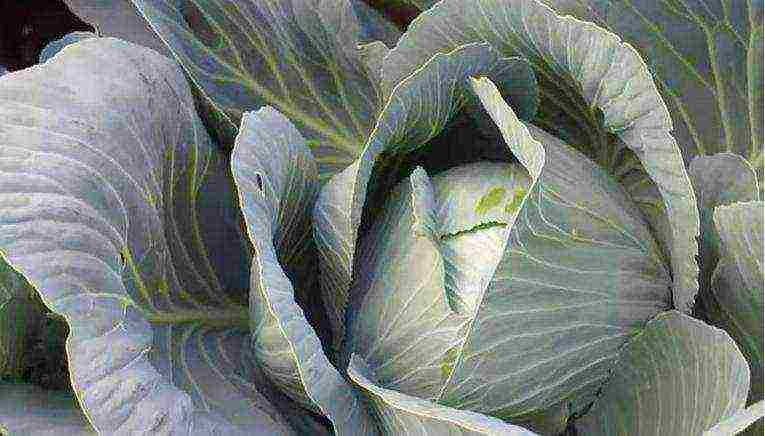
Photo of cabbage of medium late ripening variety Fundaxi
Liquid dressing is usually carried out in dry weather. In 10 liters of water, 20-25 g of ammonium nitrate, 30-40 g of superphosphate, 20-25 g of potassium chloride are dissolved. One watering can (10 liters) watered 18-20 plants.
Organic feeding of late and mid-season cabbage is given with a solution of mullein (1 part per 7 parts of water) or bird droppings (1: 15) per 10 liters of solution, add a glass of ash.
When growing white cabbage, dry fertilizers are applied when the soil is wet, scattering them along the aisle, and then immediately embedded in the soil with a hoe during loosening or hilling.
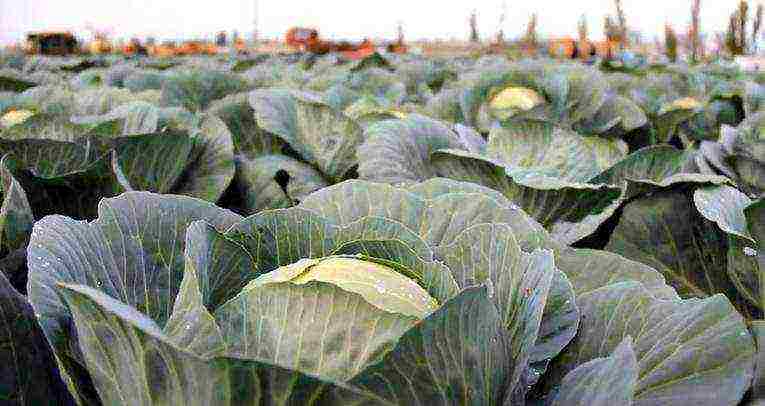
In the photo, a hybrid form of late white cabbage Centurion F 1
Cabbage has a lot of pests. From the very first day of planting, you must carefully monitor their appearance, daily examining the leaves of the plants. Already with a single appearance of pests on the heads of mid-season and late cabbage, it is necessary to immediately take measures to destroy them.
Medium late varieties and hybrids of white cabbage
Variety Brigadier F1 Is a light green hybrid of medium late white cabbage of the summer-autumn cultivation cycle, which is suitable for processing and further storage for up to 5 months. Quality heads of cabbage with a snow-white, dense inner structure, good for fermentation. Also grown for sale - on the fresh market - when the end consumer needs larger heads. White cabbage of this variety ripens in 110-120 days. When grown, the number of plants per 1 hectare is about 35,000. The weight of a head of cabbage Brigadier F1 is from 3 to 4 and a half kilograms, and with more rarefied crops - four to six kg. High content of vitamin "C", cabbage variety Brigadier F1 tolerates low temperatures, good standing in the field is noted for up to 42 days.
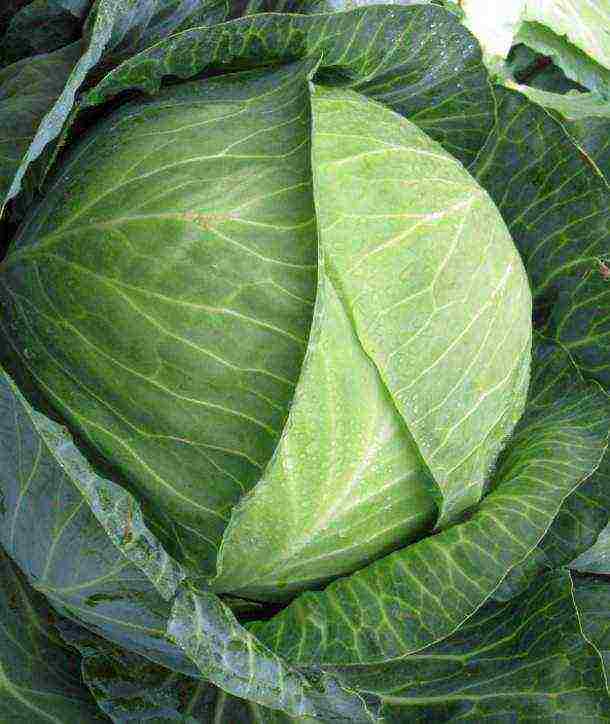
Photo hybrid of cabbage Brigadier F1
Another medium-late hybrid with high yields is Krautman F1. It is able to maintain its presentation in the field (gray-green heads of cabbage weighing 2-5 kilos) for a long time without cracking the head.The mid-ripening Krautman F1 cabbage combines the ability to preserve up to 4 months and excellent pickling qualities for cabbage. For industrial cultivation of the Krautman F1 cabbage hybrid, we recommend setting a planting density of up to 42,000 cabbage plants of this variety per hectare.
Video about one of the best cabbage hybrids Megaton F1:
Present - a productive variety of mid-ripening white cabbage (ripening period 115-135 days). Heads of cabbage are dense, rounded, stored for 6 months. The average weight of one head of cabbage of the Podarok variety is 3.0-3.5 kg. Marketability is approaching 100%. Used fresh and for processing.

Photo of a head of mid-ripening white cabbage variety Podarok
Kashirka 202 - one of the best pickling varieties of white cabbage. Heads of cabbage are dense, large, rounded, on a high cabbage stump. The mass of a head of cabbage variety Kashirka 202 is up to 8 kg. Demanding on moisture and soil.
Likurishka 498/15 - heat-resistant mid-season variety. Cabbage heads up to 2-3 kg, dense, round-flat or rounded with a slope upward. Taste qualities of cabbage variety Likurishka 498/15 are good, suitable for pickling.
|
Read an article on the different types of cabbage |
Winter mushroom - cabbage heads are round (photo below), dense, weighing up to three kilograms, are distinguished by good transportability. Cabbage variety Winter Gribovskaya is used for winter storage, pickling. Moisture-loving.
Winter mushroom 13 - hygrophilous, resistant to keel. For the rest of the characteristics and for the purpose it is close to the variety Zimnyaya Gribovskaya.
Ladozhskaya 22 - a productive variety. This cabbage is distinguished by its high resistance to keel. Heads of cabbage are dense, round, of medium size. Used for fermentation, heads of white cabbage of the Ladozhskaya 22 variety are perfectly stored fresh until February.
Yielding - a high-yielding, kilo-resistant variety. The heads of cabbage are juicy and resistant to cracking. Used white cabbage of the Urozhaynaya variety for pickling, and also suitable for long-term storage.
Late-ripening cabbage varieties
Amager 611 - this variety of late-ripening cabbage (from planting cabbage seedlings to harvest takes 118-149 days) is used for long-term winter storage (until April). His heads of cabbage are medium-sized, very dense, weighing 2-4 kg, the heads of cabbage are flat-round in shape, the stump is small. When growing cabbage variety Amager 611, the yield can be more than 6 kg per square meter. Valuable for long distance transportation.
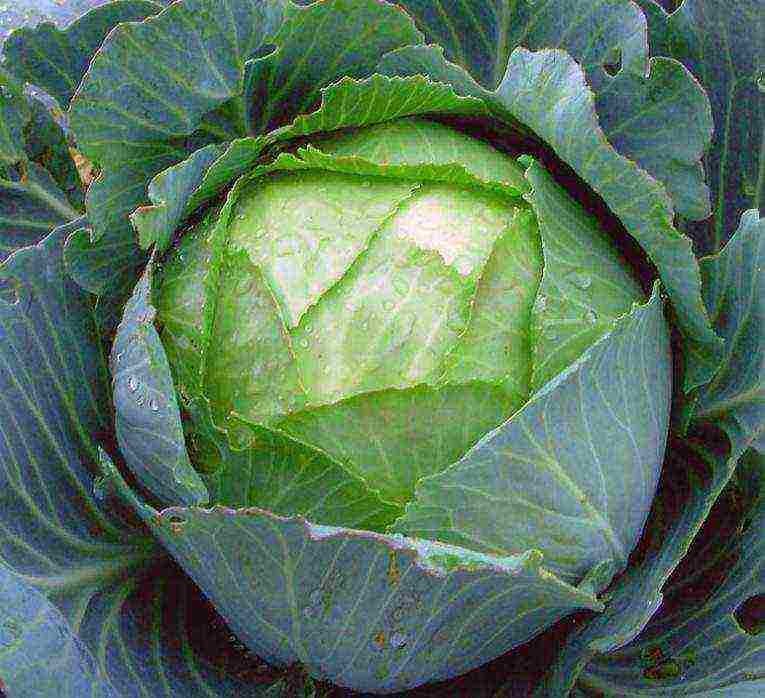
In the photo, the variety of cabbage Amager 611
Moscow late 15 - round and dense heads of cabbage of this late ripening cabbage are large, reaching a mass of 3-5 kg. Cabbage variety Moskovskaya Late 15 is demanding on moisture and soil fertility. Has a relative resistance to keel. Not suitable for storage, but excellent cabbage variety for pickling.
Wintering 1474 - late cabbage (130-150 days), stored until the new harvest (has a marketability of up to 90% by 6 months). Moreover, over time, the taste of Zimovka only improves. Unsurpassed variety for tenderness of heads of cabbage (dense, round, weighing 2-3 kg).
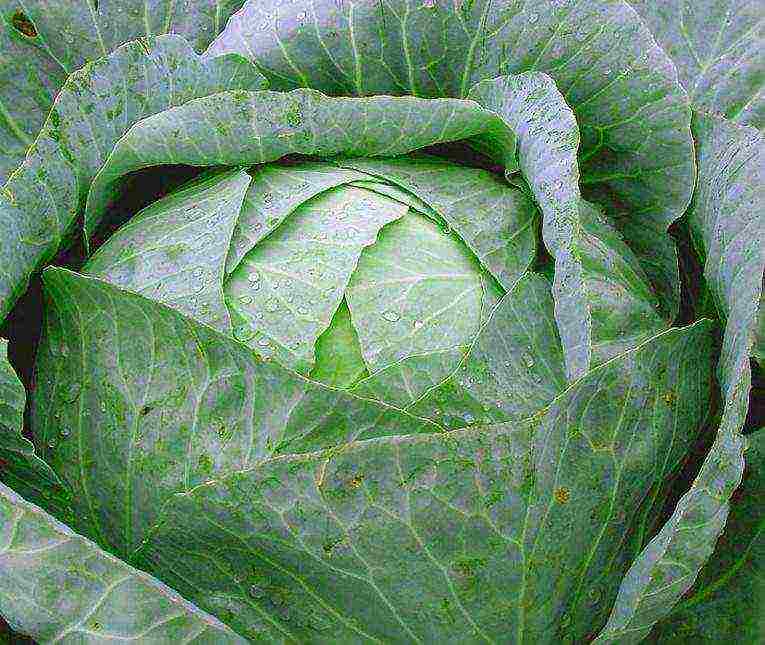
In the photo Wintering 1474
Variety Moscow late 9 - white cabbage, which, when grown on seasoned soils, gives a higher yield than Moscow late 15. The varieties are similar in use and morphology.
Mushroom hybrid 1- a universal variety for the use of the crop. Dense heads of cabbage, round-flat, good taste, well stored in winter.
Rusinovka - vegetation period is 135-160 days; when grown, late-ripening white cabbage reaches a mass of 3 kg or even more. Rusinovka is suitable for fermentation, keel resistant.
Video about an excellent variety of white cabbage for pickling and storage - a hybrid Centurion F1:
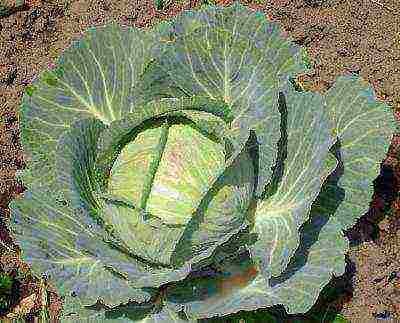 White cabbage varieties are divided into several types:
White cabbage varieties are divided into several types:
- Early maturing, with a short growing season (65-115 days from germination to technical ripeness). These varieties are distinguished by medium-sized, medium-density heads of cabbage, delicate, thin leaves. They are used fresh and for the preparation of various dishes. Not suitable for fermentation and storage.
- Mid-season (115-150 days).During the summer period, cabbage of these varieties forms normal heads of cabbage, surpasses the early varieties in yield. Mid-season varieties differ in purpose - there are varieties for fermentation, there are varieties for long-term storage.
- Late ripening (150 days or more). In late varieties, heads of cabbage are denser than in mid-season or early ones. Used for long-term storage and fermentation.
The success of the harvest depends a lot on the right varieties. There are a large number of varieties and hybrids created for different climatic zones. Here are the varieties adapted for widespread cultivation.
Early varieties
June... Early (90-110 days from germination to technical ripeness) variety. Heads of cabbage with a diameter of 14-20 cm, weighing 0.9-2.4 kg., Round, medium density, good taste.
Zarya MC... Early (107-118 days from germination) variety. The head of cabbage is round, weighing 1.6-2 kg., Medium density, does not crack.
Dumas F1... Early ripening (110 days from germination) hybrid. The head of cabbage is round, weighing 0.8-1.5 kg. Medium crack resistance, suitable for thickening planting.
Early ripening... Early (94-103 days from germination) variety. The head of cabbage is round, 11-19 cm in diameter, weighing 0.9-2 kg, dense. Prone to cracking, affected by keel, weakly affected by spring fly.
Transfer F1.Early (96-118 days from germination) hybrid. Heads of cabbage with a diameter of 15-17 cm, weighing 0.8-1.5 kg., Round, medium density, good taste. The variety is resistant to pathogens of vascular bacteriosis, strongly affected by fusarium, wilting and keel.
Malachite F1... Early (92-137 days from germination) hybrid. The head of cabbage is round, 16-17 cm in diameter, weighing 1.3-1.5 kg, medium density, good taste. The variety is affected by the keel, moderately resistant to vascular bacteriosis.
Cossack F1... Early (106-112 days from germination) hybrid. The head of cabbage is round, with a diameter of 15.5-17.5 cm, weighing 0.8-1.2 kg, dense, of excellent taste. The variety is resistant to mucous bacteriosis and black leg, moderately resistant to keel. Resistant to cracking.
Number one Gribovsky 147... Early (102-117 days from germination) variety. Heads of cabbage are round, 16-23 cm in diameter, weighing 0.9-1.9 kg, medium density, good taste. It is prone to damage by vascular bacteriosis, it is strongly affected by the keel.
Dot... Early (98-123 days from germination) variety. Heads of cabbage are conical, 17 cm in diameter, 0.7-1.7 kg in weight, medium density, loose.
Mid-season varieties of white cabbage
Glory 1305... Mid-season (105-130 days from germination) variety. The head of cabbage is round and round-flat, weighing 4-5 kg., Dense, resistant to cracking. The variety is susceptible to keel, vascular bacteriosis, fusarium wilt. For fresh consumption, pickling, heads of cabbage are stored until January.
Hope... Mid-season (120-135 days from germination) variety. The head of cabbage is round or round-flat, weighing 2.4-4.5 kg., Good density, does not crack. It is intended for fresh consumption and for fermentation.
Belarusian 455... Mid-season (105-130 days from germination) variety. Heads of cabbage are round-flat, weighing 1.3-4.4 kg., Dense, do not crack. Suitable for fermentation. Stored until December-January.
SB-3 F1... Mid-season (130-135 days from germination) hybrid. The head of cabbage is round, weighing 3.0-4.5 kg., Dense, excellent taste. High-yielding. The variety is resistant to causative agents of the main diseases of cabbage. For fresh consumption and fermentation.
Krautman F1... Mid-season (123-135 days from germination) hybrid. Heads of cabbage weighing 3-4 kg., Dense, Resistant to cracking. High-yielding.
Rinda F1... Mid-season (123-140 days from germination) hybrid. Heads of cabbage are round, weighing 3.2-3.7 kg. (up to 8 kg.), dense, excellent taste. Resistant to major diseases of cabbage, to cracking. For fresh consumption and for processing.
Menza F1... Mid-season (125-140 days from germination) hybrid. Heads of cabbage are round-flat, weighing 4-9 kg, dense, of excellent taste. The variety is resistant to adverse weather conditions. It is intended for fresh consumption, fermentation, long-term (until March) storage.
Midor F1... Mid-season (125-140 days from germination) hybrid. The head of cabbage is round and flat-round, weighing 2.3-4 kg., Medium-dense, excellent taste.It is intended for fresh consumption, fermentation and long-term storage.
Tobia F1... Mid-season (125-140 days from germination) hybrid. A head of cabbage weighing 4-8 kg., Dense, excellent taste. It is intended for fresh consumption, processing and storage (up to 6 months).
Late-ripening varieties of white cabbage
Amager 611... Late (145-167 days from germination) grade. Heads of cabbage are round-flat, weighing 2.4-6.1 kg., Dense. The palatability improves during storage. The variety is not resistant to pathogens of vascular bacteriosis, moderately resistant to keel. For long-term storage.
Gingerbread man F1... Late (144-150 days from germination) hybrid. Heads of cabbage weighing 4.2 kg., Round, dense, excellent taste. It is affected by keel and cabbage fly. Medium resistant to white rot pathogens. For fresh use, fermentation and long-term storage.
Creumont F1... Late (165-170 days from germination) hybrid. Heads of cabbage are round or flat-round, weighing 1.9-2.1 kg., Dense, good taste. The variety is resistant to vascular and mucous bacteriosis, to cracking. For long-term storage.
Extra F1... Late ripening (155-160 days from germination) hybrid. Heads of cabbage are round-flat, weighing 2.5-2.8 kg., Good taste, dense, do not crack. The variety is resistant to a complex of diseases. For fresh consumption, fermentation and long-term storage.
Smooth F1... Late (146-163 days from germination) hybrid. Heads of cabbage weighing 1.8-2.3 kg., Round, dense, good taste. Stable yield. Moderately susceptible to keel. For long-term storage.
Moscow late 15... Late (145-160 days from germination) grade. Heads of cabbage are round or flat-round, medium density, weighing 3.3-4.5 kg., Excellent taste. The yield is high. The variety is susceptible to fusarium wilt and downy mildew. Suitable for fermentation.
Sugar Loaf... Late ripening (130-160 days from germination) variety. Heads of cabbage are round, weighing 3-4 kg., Dense, sweet, juicy. The variety is suitable for fermentation and long-term storage (until May-June).
Megaton F1... Medium late (142 days from germination) hybrid. The head of cabbage is round, dense, weighing up to 10 kg., Excellent taste. Resistant to fusarium, moderately resistant to keel and gray rot.
Present... Late (145-165 days from germination) grade. Heads of cabbage are round, weighing 2.0-3.6 kg., Dense, good taste. High yield, excellent storage. The variety is susceptible to fusarium wilting, mucous and vascular bacteriosis, keel.
Wintering 1474... Late ripening (165-175 days from germination) variety. The head of cabbage is flat-rounded, weighing 3.6 kg. The palatability improves during storage. For long-term (up to 8 months) storage.
